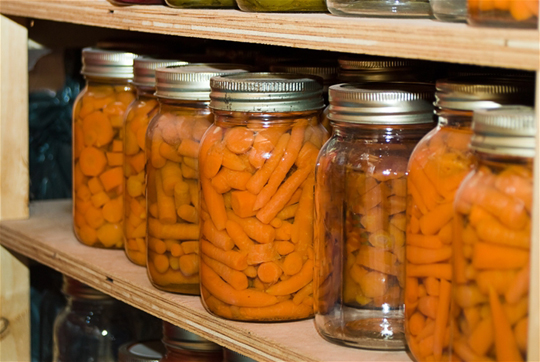
Food Storage Tips
Maintaining the quality and ultimately preserving your food source should be a top priority when it comes to creating a food supply. Nothing is more dangerous than a disaster occurring and suddenly realizing your food supply has been contaminated. In order to keep your food well preserved, you should avoid the following enemies.
Heat
Heat will dramatically decrease the shelf life of your food supply. Your food should be kept in a cool area, which is preferably climate controlled. A small air conditioning unit might be a wise investment if you are building a larger food supply room.
Air
Exposure to air can also dramatically reduce the shelf life of your food supply. You need to ensure you are familiar with vacuum sealing if you are going to store your food to prevent air getting to it. Investing in oxygen absorbers will also allow you to remove any oxygen that could contaminate your food supply.
Light
Light is another enemy of your food supply. Light will not only decrease the shelf life of your food, but it will also increase the heat inside your room. Make sure your food is kept in a dark/cool location.
Humidity/Moisture
Moisture and humidity are also known to decrease the shelf life of your food supply. Make sure your food is kept in a cool and dry place. Look at investing in a dehumidifier and moisture control apparatus. Cans that store foods can rust quickly in damp environments and thus compromise the contents.
Expiration Dates
Even though you are saving up food for your emergency supply, you need to make sure you rotate it sufficiently. Many types of food have expiration dates that you may not have realized. Bottled water and even canned goods have a specific shelf life. Many people think that their food supply is for emergencies only and should not be touched so, this can lead to the food being wasted due to expiration. Your food supply should not be avoided instead it should be consumed and rotated. This means you are constantly using your food supply every day. Just be sure that once you use one item, you must purchase a new one and “rotate” the new item to the back of the supply line. This will allow you to use the food that is closer to expiration and keep fresher food and supplies ready in case of an emergency.
Pests
Pests can chew their way through and contaminate your food supply and foods made with grains are particularly susceptible to grain weevils that burrow inside the grain hulls and seeds to deposit larvae. You need to actively monitor your food supply and take the proper steps to fix the problems should they arise.
Where do you Store Your Food
Canned and packaged non-perishable foods can be stored anywhere inside the homes, such as a spare bedroom or a climate-controlled basement. Most experts will recommend that you divide your supplies up so if there is a break in the intruders do not have access to all of your supplies at the same time.
What Do You Store Your Food In
When you are storing your food, it is important to make sure the food is in the proper containers to increase its overall self-life. You can use mason/canning jars and food grade plastic buckets. Do not use any containers that were used to store anything other than food products. Be cautious of home improvement buckets, as they are not the same quality as food grade buckets. Mylar bags are also a great way to keep your food preserved and easy to store. Mason jars can be vacuum-sealed and many sealers come with the device to seal the lids.
Start Small
If you are new to prepping and food storage, this may seem a bit overwhelming at first. Start small and build a stockpile a little at a time to reduce the economic burden. An adequate food supply for you and your family will take time.
Test
Many survival foods are purchased in large bulk orders to save the buyer money. This can lead to purchasing food items that you may not necessarily care for but bought it because it was on sale in large quantities. Dehydrated and frozen food ingredients can also taste quite different then their fresher counterparts. You should always test out and purchase small amounts of food supplies before making the jump with much larger purchases. Try out different recipes and food items until you have narrowed down your list to items your whole family will enjoy. Make sure everyone in the family has foods they like because there is no point in spending money on foods no one likes just because they were on sale.

0 comments:
Post a Comment